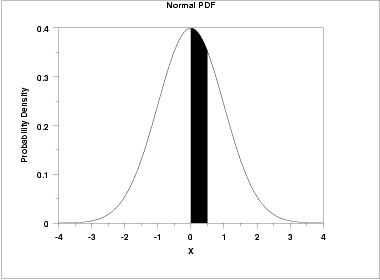1.3. EDA Techniques
1.3.6. Probability Distributions
1.3.6.7. Tables for Probability Distributions
1.3.6.7.1. |
Cumulative Distribution Function of the Standard Normal Distribution |
The table utilizes the symmetry of the normal distribution, so what in fact is given is
-
\( P[0 \le x \le |a|] \)

This can be clarified by a few simple examples.
- What is the probability that x is less than or equal to
1.53? Look for 1.5 in the X column, go right to the 0.03 column
to find the value 0.43699. Now add 0.5 (for the probability
less than zero) to obtain the final result of 0.93699.
- What is the probability that x is less than or equal to
-1.53? For negative values, use the relationship
\( P[x \le a] = 1 - P[x \le |a|] \;\;\;\;\; \mbox{for $x < 0$} \)
From the first example, this gives 1 - 0.93699 = 0.06301.
- What is the probability that x is between -1 and 0.5? Look up the values for 0.5 (0.5 + 0.19146 = 0.69146) and -1 (1 - (0.5 + 0.34134) = 0.15866). Then subtract the results (0.69146 - 0.15866) to obtain the result 0.5328.
| p | 0.001 | 0.005 | 0.010 | 0.025 | 0.050 | 0.100 |
| Zp | -3.090 | -2.576 | -2.326 | -1.960 | -1.645 | -1.282 |
| p | 0.999 | 0.995 | 0.990 | 0.975 | 0.950 | 0.900 |
| Zp | +3.090 | +2.576 | +2.326 | +1.960 | +1.645 | +1.282 |
These are critical values for the normal distribution.

